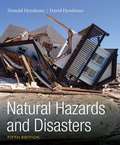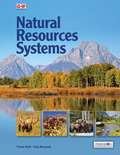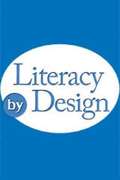- Table View
- List View
Natural Disasters
by Patrick Leon AbbottNatural Disasters, 11th edition focuses on explaining how the normal processes of Earth concentrate their energies and deal heavy blows to humans and their structures. Students have a natural curiosity about natural disasters and why they occur. This text explains why natural disasters occur by interweaving the themes of Energy sources, Plate tectonics, climate change, Earth Processes, geologic time, the complexities of multiple variables operating simultaneously throughout the text. Detailed and interesting Case histories are also intertwined with current content to give students a broad historical understanding of our dynamic and evolving planet.
Natural Disasters (7th edition)
by Patrick Leon AbbottNatural Disasters, 7th edition, focuses on how the normal processes of the Earth concentrate their energies and deal heavy blows to humans and their structures. It is concerned with how the natural world operates and, in so doing, kills and maims humans and destroys their works. Throughout the book, certain themes are maintained: energy sources underlying disasters plate tectonics and climate change; earth processes operating in rock, water, and atmosphere; significance of geologic time; complexities of multiple variables operating simultaneously; detailed and readable case studies.
Natural Hazards and Disasters (Fifth Edition)
by Donald Hyndman David HyndmanSucceed in your course with NATURAL HAZARDS AND DISASTERS, 5e. The authors provide easy-to-understand coverage of the geological processes that underlie disasters, explore the impact these processes have on humans and vice versa, and analyze strategies for mitigating these hazards' physical and financial harm. From timely information on recent natural disasters in the United States and around the world to insights on earthquakes associated with fracking, this fascinating book provides the up-to-date information you need to analyze potential hazards and take the steps necessary to survive a natural disaster.
Natural Resources
by Jasper S. LeeNatural Resources covers the following topics: IMPORTANCE OF NATURAL RESOURCES CONSERVING RENEWABLE NATURAL RESOURCES LAND CONSERVING NONRENEWABLE NATURAL RESOURCES SUSTAINING NATURAL RESOURCES ENJOYING NATURAL RESOURCES
Natural Resources Systems
by Travis D. Park Tara L. BerescikNatural Resources Systems is a comprehensive text that features up-to-date coverage of today's natural resources management, including a focus on sustainability, global environmental issues, and the science behind the solutions to natural resources issues. It provides students with a basic introduction to many areas included in natural resources studies, including soil, air, water, endangered species, fisheries, game management, and cartography. Diverse conservation and natural resources management careers are highlighted in the Career Connection features throughout the text to provide students with examples of career paths taken by some of today's successful professionals. Special attention is given to the art of program, which includes pictures, charts, graphs, and illustrations, to education readers and help those who struggle with comprehension. Abundant STEM Connections, Environmental Features, and instructional features throughout the text help students learn by doing.
Natural Selection Engineering Internship: Fighting Drug-Resistant Malaria, Engineering Notebook, with Article Compilation
by The Lawrence Hall of ScienceNIMAC-sourced textbook
Natural Selection: Poisonous Newts, Investigation Notebook with Article Compilation, Grade 8
by The Lawrence Hall of ScienceNIMAC-sourced textbook <p>Grade 8</p>
Naturalistic and Incidental Teaching
by Marjorie H. CharlopNaturalistic teaching strategies (NaTS) are evidence-based interventions, rooted in applied behavior analysis, that are carried out in loosely structured environments, such as play settings, home settings, or community settings, that are more akin to what occurs in the natural environment. They have similar philosophical approaches, similar treatment components, and thus similar treatment outcomes. NaTS are considered naturalistic not only because of the setting but also because of the manner of delivery. Behavior change agents often come from nontherapeutic environments, such as parents or teachers, or even peers and siblings. NaTS are well suited to teaching behaviors that tend to occur in the natural environment, such as those pertaining to communication and social skills. NaTS often utilize or mimic a typical daily setting.
Nature Lover #6 (Jada Jones)
by Kelly Starling LyonsJada Jones is back for the sixth book of this popular, celebrated series perfect for STEM fans!"Readers who love Ivy and Bean or Katie Woo will want to meet Jada Jones." --School Library JournalJada is thrilled when she gets to go on an outdoor class field trip with her Pop Pop, a nature lover, as a chaperone. She can't wait to show him off to her friends--and show him what she knows. But the trip has some twists along the way, including a soaring zip line she's not sure she wants to try. What happens when Jada's shining moment starts to lose its luster?Praise for Jada Jones: Rock Star"Fast-paced, with supersimple vocabulary and a smattering of earth science to spark interest in young rock collectors everywhere." --Kirkus Reviews
Nature in the Extreme: Volcanic Eruptions; San Francisco Shaking!
by Marian Calabro Meish GoldishNIMAC-sourced textbook
Nature's Pockets (Fountas & Pinnell Classroom, Guided Reading Grade 3)
by Janet Palazzo-CraigNIMAC-sourced textbook
Nature's Recycling Team (Fountas & Pinnell Classroom, Guided Reading Grade 4)
by Christy PetersonNIMAC-sourced textbook







